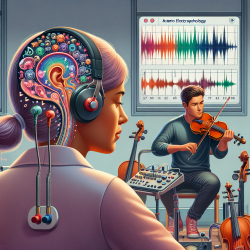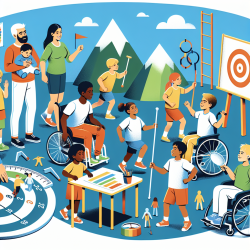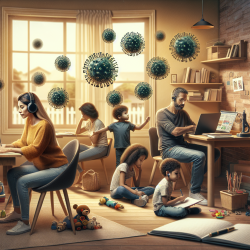Introduction
As practitioners in the field of speech-language pathology, we are constantly seeking ways to improve outcomes for our clients. A recent study, "Auditory Electrophysiological and Perceptual Measures in Student Musicians with High Sound Exposure," provides valuable insights into how noise exposure affects auditory processing in musicians. This research can guide us in refining our approaches to therapy, particularly for clients with a background in music.
Understanding the Study
The study examined the influence of noise exposure on the auditory systems of student musicians compared to non-musicians. It focused on auditory brainstem responses (ABRs) and speech-in-noise abilities. The findings highlighted a negative association between noise exposure and performance on speech-in-noise tasks, particularly at the word level, among musicians.
Key Findings and Implications
- Noise Exposure and Speech-in-Noise Performance: The study found that high noise exposure negatively impacted musicians' ability to recognize words in noisy environments. This suggests that noise exposure can compromise auditory processing abilities, which is critical for speech-language pathologists to consider when working with clients who have a history of high noise exposure.
- Electrophysiological Measures: Despite the negative impact on speech-in-noise performance, the study did not find significant differences in ABR wave amplitudes between musicians and non-musicians. This indicates that traditional audiometric measures may not fully capture the subtle effects of noise exposure on auditory processing.
- Central Auditory Processing: The lack of significant findings in P300 measures suggests that noise exposure may not affect all central auditory processing pathways equally. This highlights the need for comprehensive assessments that include both peripheral and central auditory measures.
Practical Applications for Practitioners
For practitioners, these findings emphasize the importance of considering a client's noise exposure history, particularly for those with musical backgrounds. Here are some practical steps to implement these insights:
- Comprehensive Auditory Assessments: Incorporate both electrophysiological and behavioral measures in assessments to capture the full extent of auditory processing abilities.
- Tailored Intervention Strategies: Develop personalized therapy plans that address specific deficits in speech-in-noise perception, especially for clients with high noise exposure backgrounds.
- Education and Prevention: Educate clients, especially musicians, about the risks of noise exposure and strategies to protect their hearing, such as using ear protection during rehearsals and performances.
Encouraging Further Research
While this study provides valuable insights, it also highlights the need for further research. Larger sample sizes and longitudinal studies could provide more definitive conclusions about the long-term effects of noise exposure on auditory processing. Practitioners are encouraged to stay informed about ongoing research in this area and consider participating in studies that explore these dynamics further.
To read the original research paper, please follow this link: Auditory Electrophysiological and Perceptual Measures in Student Musicians with High Sound Exposure.










